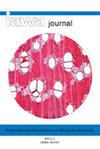Age of heartwood initiation in trunks of young Pinus sylvestris L. trees in the taiga zone
IF 3.5
3区 农林科学
Q2 FORESTRY
引用次数: 0
Abstract
This work is part of a project investigating the heartwood formation process in Scots pine. Despite the economic and ecological importance of pine heartwood (HW), the process of its formation in many respects remains poorly understood. Scientists believe that HW formation in Scots pine begins at 9–20 years, however, systematic studies of HW initiation age in this species have not previously been conducted. Samples were collected from 105 P. sylvestris trees aged 10 to 25 years, growing in the middle and northern taiga subzones, as well as on the border of the northern taiga subzone with the tundra. Samples were taken at the trunk base according to a single technique and processed using two biochemical (peroxidase activity, pinosylvin presence) and two anatomical markers (presence of extractives on the tracheid pit membranes, nuclei disappearance) characterizing different events during HW formation. Biochemical markers showed an overestimation in the number of HW annual rings compared with HW determination based on anatomical criteria by 1–3 years, on average. Attempts to detect peroxidase activity showed a negative result in the inner sapwood annual ring, while detectable pinosylvin accumulation occurred in the transition zone (TZ). We have detected for the first time true HW (without living cells) in Scots pine samples with a cambial age (CA) of 15–17 years. The number of growth rings in TZ and HW in young trees depended on growth conditions. These results are important for understanding the mechanisms of HW formation and developing realistic models of this process, including changing climate conditions.泰加地区欧洲赤松幼树树干心材形成的年龄
这项工作是苏格兰松树心材形成过程研究项目的一部分。尽管松树心材(HW)具有重要的经济和生态意义,但人们对其形成过程的许多方面仍然知之甚少。科学家们认为,苏格兰松的心材形成始于 9-20 年,但此前尚未对该树种的心材形成年龄进行过系统研究。我们从生长在泰加亚区中部和北部以及泰加亚区北部与苔原交界处的 105 棵树龄为 10-25 年的苏格兰松树上采集了样本。根据单一技术在树干基部取样,并使用两个生化标记(过氧化物酶活性、松果菊酯)和两个解剖标记(气管凹陷膜上的萃取物、核消失)进行处理,这两个标记表征了 HW 形成过程中的不同事件。生化标记显示,与根据解剖学标准确定的 HW 相比,HW 年轮的数量平均高估了 1-3 年。检测过氧化物酶活性的尝试在边材年轮内部显示出阴性结果,而在过渡区(TZ)则出现了可检测到的松脂醇积累。我们首次在苏格兰松树样本中检测到真正的 HW(无活细胞),苏格兰松树的韧皮部年龄(CA)为 15-17 年。幼树 TZ 和 HW 的生长年轮数量取决于生长条件。这些结果对于了解 HW 的形成机制和开发这一过程的现实模型(包括不断变化的气候条件)非常重要。
本文章由计算机程序翻译,如有差异,请以英文原文为准。
求助全文
约1分钟内获得全文
求助全文
来源期刊

IAWA Journal
农林科学-林学
CiteScore
3.40
自引率
15.80%
发文量
26
审稿时长
>36 weeks
期刊介绍:
The IAWA Journal is the only international periodical fully devoted to structure, function, identification and utilisation of wood and bark in trees, shrubs, lianas, palms, bamboo and herbs. Many papers are of a multidisciplinary nature, linking
 求助内容:
求助内容: 应助结果提醒方式:
应助结果提醒方式:


